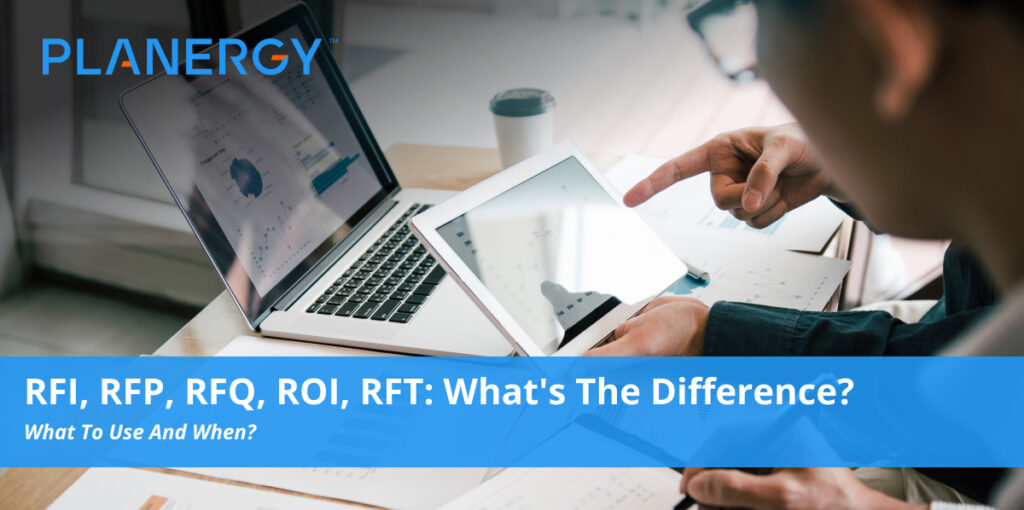If you work in procurement, you know that there are a lot of acronyms to keep track of. But what do they all mean?
In this blog post, we’ll break down the meaning of five commonly used procurement acronyms: RFI, RFP, RFQ, ROI, and RFT.
RFI: Request for Information
An RFI is issued when a procuring organization wants more general information about a potential vendor or solution. It is typically used at the beginning of the procurement process to help the organization narrow its options.
You may also use an ROI: Registration of Interest. An ROI, also called an Expression of Interest or EOI, is not a solicitation for bids but a way for organizations to gauge interest from potential suppliers.
It’s similar to an RFI, but is often used as a shortlisting or screening tool.
It allows organizations to assess whether or not there are suppliers capable of providing the goods or services they need before committing to issuing an RFP or RFQ.
At this point, you’re not necessarily committed to buying. You’ll likely send additional requests if you find the vendor may be able to meet your organization’s needs.
Benefits of RFIs
Buyers can provide information about prices, quality, delivery times, and other important factors when purchasing.
RFIs can also help buyers identify potential suppliers and compare them against each other, which is crucial for strategic sourcing.
For suppliers, RFIs can be a way to market their products and services and learn more about what buyers are looking for.
Additionally, submitting a proposal in response to an RFI can help suppliers build relationships with buyers and potentially win future contracts.
When to Use RFI
Use this document when you have an idea of what you want, but require more information from suppliers.
You’re not committed to buying here and can submit additional documents and requests as you narrow down your potential solutions.
Your RFI template should include the following sections:
- Project description, project goals, and background: Your goals and objectives with the project
- Company information: Background information about your company and where the project fits into your overall goals.
- Supplier requirements: The things you’re looking for in a vendor, such as credentials and skills.
- Submission instructions: How you want the companies to submit their responses.
- Requested information: Your questions about the supplier organization, experience, pricing, and solutions.
Best Practices
Because the request for information is used at the beginning of your procurement processes, you should:
- Limit specifics and keep project information general
- Provide as much background information as you can about the project and your challenges
- Concisely summarize your business needs
- Clearly describe how you what the RFI to be answered
You should ask for general information, such as company goals and objectives. You should also include the following:
- An outline of your supplier’s credential requirements, including capacity and skills
- Open-ended questions about the supplier’s business, including track record, solutions, and certifications
Make sure to have a system to track your RFI responses to decide if you want to move forward and send an RFP.
An easy way to remember the difference between these documents is: RFIs educate, RFPs compare, and RFQs quantify.
RFP: Request for Proposal
An RFP is issued when an organization is ready to solicit proposals from vendors. It outlines the requirements for the project and evaluates the ability of various vendors to complete the project successfully.
Benefits of RFPs
They allow for a more fair and open procurement process, as all interested vendors have an equal opportunity to submit a proposal.
This also allows for better vendor management, as the best vendor for the job can be easily identified.
Additionally, RFPs help to build strong partnerships with qualified vendors, fostering a collaborative environment in which both the buyer and seller can benefit.
Ultimately, RFPs create a more efficient and effective procurement process, resulting in cost savings and improved quality of goods and services.
When to Use RFP
Use this document when you know you have an issue but aren’t sure about how to solve the problem. This is a formal document that adheres to strict guidelines for content, timeline, and vendor responses.
At this point, you’re seeking a solutions-based solution to meet your need, but you may or may not have clear specs to follow. It has more flexibility than a request for tender (RFT) document and is acceptable for soliciting professional services.
Best Practices
Compared to an RFI, an RFP will include different information. It gives suppliers enough data to submit their proposals to complete your project. This document should include things like:
- A summary of business needs
- Introduction to you as a buyer and your company background
- Project scope and goals
- Project price and payment terms
- Any relevant attachments
- Minimum vendor requirements
- Timeline
- Sections and questions
- Terms and conditions
You’re free to include more information, as there isn’t a standard to follow when drafting an RFP.
You’re good if you provide relevant information to suppliers so they can give you an informed offer.
Ideally, you’ll want to include your stakeholders in this phase, so you can follow an accurate procedure for your company.
By investing time in creating templates to standardize your internal RFP processes, you’ll be better equipped to vet your vendors.
RFQ: Request for Quotation/Request for Quote
RFQ is similar to an RFP but is usually used for simpler projects with well-defined requirements.
Vendors are asked to submit price quotes for the project, and the procuring organization chooses the vendor with the best price.
Benefits of RFQs
- Increased competition: When you issue an RFQ, you invite suppliers to compete for your business. This can lead to better prices and products as suppliers try to outdo each other.
- Reduced costs: By issuing an RFQ, you’re letting suppliers know upfront what you’re looking for. This can help prevent unnecessary spending and save you time and money in the long run.
- Better quality products: With more competition, suppliers are more likely to offer high-quality products and services to win your business.
- Streamline the procurement process: Using RFQs can help speed up procurement by eliminating suppliers unsuitable for your needs.
When to Use It
You should use the RFQ when you have clearly defined specifications or criteria. Use this when judging a supplier or a product solely on price and are committed to buying.
You’ll use this most often when you know what you want but need information from vendors about how they’ll meet your requirements and what they’ll charge.
Best Practices
At this point, you’re committed to buying; you just don’t know which vendor you’re purchasing from. That’s why you’ll need to draft a set of detailed requirements to get an accurate quote.
Be as specific and detailed as possible about your project requirements and the tasks you’ll need to accomplish. This ensures you’ll have all the data you need to do your due diligence during the selection process. Make sure to include:
- An introductory summary with an outline of your project requirements
- Selection criteria
- Contract requirements and completion dates
- Cost and pricing information
- Contact details
To keep things simple, collect all the information for each vendor on your shortlist in a central location. That will make it easier for you decide who to contact before sending your RFQ to bidders.
RFT: Request for Tender
Requests for tender (RFTs) play an important role in public procurement.
They allow buyers to assess the capabilities of potential suppliers and select the most qualified supplier.
Benefits of RFT
- They ensure fairness and transparency in the procurement process.
- They help buyers identify the most qualified suppliers.
- They allow suppliers to understand the buyer’s requirements and submit a proposal that meets them.
When to Use RFT
An RFT is used when an organization intends to award the contract to the supplier who provides the best value, not necessarily the lowest price.
In addition to cost, factors such as quality, delivery time, and experience may be considered when evaluating bids from different suppliers.
RFTs are more commonly used with government and businesses that are government-funded.
Best Practices
A RFT should follow a similar structure to a RFP. Include:
- Company background and where the project fits
- Project description
- Your supplier evaluation process
- A response form to make it easier for suppliers to send their response
- Legal documentation, such as terms and conditions, payment terms, contingencies for cancelation
- Contact details
Make sure to follow all legal requirements and give vendors a clear response format.
Challenges of Managing RFI vs RFP vs RFQ
Companies’ biggest problem when dealing with these processes is the lack of standardization.
You need to create an internal process that means your business needs. As your company grows, the problem becomes more obvious.
Ideally, you’ll manage all your requests and proposals by:
- Keeping your RFIs, RFPs, and RFQs in a centralized database
- Accurately maintaining a supplier database
- Quickly and efficiently making cost-effective decisions on future projects
- Actively working to improve supplier relationships
Making the Most of These Valuable Documents During Vendor Selection
Understanding which type of request—RFI, RFP, RFQ, ROI, or RFT—to issue during different stages of the procurement process is critical to ensuring a successful outcome.
Organizations can save time and money by understanding the key differences between these requests while still procuring exactly what they need.




